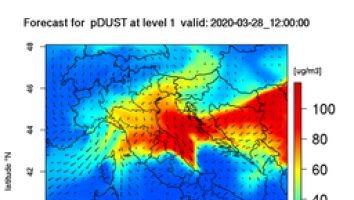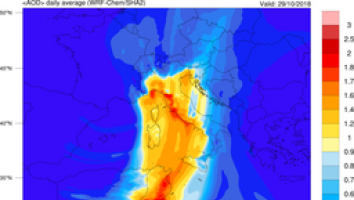The expertise in atmospheric numerical modelling acquired by ISAC covers different applications and research fields such as air quality analysis and forecast, diagnostic investigations of the major processes involved in atmospheric transport phenomena, and transformation of pollutants in both the gas and particulate phase.
Several models are applied and developed at ISAC, encompassing eulerian and lagrangian approaches, from local to global scales. The consolidated meteorological modelling chain (i.e. GLOBO-BOLAM-MOLOCH), developed by ISAC starting from 90’s, is used to provide the meteorological parameters to atmospheric composition modelling chain (e.g. CHIMERE), as well to dispersion lagrangian models (e.g. SPRAY, MICROSPRAY, MILORD, FLEXPART), for applications and studies on short to medium range time scales and for the evaluation of climate-altering species emissions through a top-down approaches.
ISAC is currently involved in the development of an interactively coupled Regional Earth System Model (RESM) to investigate the multiple atmospheric composition - climate interactions. In particular, this high-resolution RESM, will interface WRF-Chem for the atmospheric composition, ROMS/SWAN for Sea dynamics, and a specialised Sea Ice Model for the cryosphere. This will be used to study the role of trace gas and aerosol constituents on the atmospheric composition and processes and on the regional climate, including interactions with radiative, microphysical, and chemical processes. These tools are useful to deeply investigate, with a comprehensive approach important climatic hotspots such as the Mediterranean and the Arctic.
Several applications and joint model-observation efforts are carried out to shed light on acute pollution events due to the mixing of natural (e.g. mineral dust from Northern Africa, biomass burning, volcanic eruptions) and anthropogenic sources (e.g. intense heating system emissions, heavy traffic, industrial and accidental releases).
Research Project:
- NOSE (Network for Odour SEnsitivity) https://www.arpa.sicilia.it/temi-ambientali/aria/nose-network-for-odour-sensitivity/
- “The cryosphere in a changing Arctic: understanding feedbacks to climate change”, ENI-CNR joint research agreement 2019-2024.


